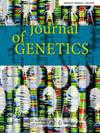飞钟、我的钟和片剂 B 受体。
摘要
在果蝇黑腹果蝇中,当其时钟神经元中的内核膜蛋白片层 B 受体(LBR)被耗尽时,昼夜节律就会被打乱(Proc.Natl.USA 118, e2019756118.2021; https://doi.org/10.1073/pnas.2019756118 and Research 6, 0139, 2023; https://doi.org/10.34133/research.0139)。通常,在昼夜节律钟的抑制阶段,时钟蛋白PERIOD(PER)会在核内膜附近形成病灶。核膜附近病灶的大小、数量和位置随 24 小时节律摆动。当 LBR 缺失时,病灶不会形成。PER病灶将per和其他时钟基因带到核膜附近,在那里它们的转录被抑制。然后,在昼夜节律钟的激活阶段,PER 蛋白逐渐降解,病灶消失。包括per在内的时钟基因会转移到细胞核内部,并在那里恢复转录。时钟基因在细胞核外围和内部之间有节奏的重新定位与它们在昼夜周期中的抑制和激活有关。LBR 的缺失破坏了这种节律。PER的磷酸化促进了病灶的形成,而蛋白磷酸酶2A的去磷酸化则使病灶消失。LBR通过破坏蛋白磷酸酶2A催化亚基的稳定性来促进病灶的形成。lbr基因对本刊来说并不陌生。本刊首次报道了脊椎动物的 LBR 也是一种甾醇生物合成酶,特别是一种甾醇 C14 还原酶(J. Genet.73, 33-41, 1994; https://www.ias.ac.in/article/fulltext/jgen/073/01/0033-0041)。人类 Lbr 基因突变会导致一系列表型--从相对良性的 Pelger-Huet 异常到围产期致命的 Greenberg 骨骼发育不良。脊椎动物 LBR 基因的苍蝇直向同源物编码一种蛋白质(dLBR),这种蛋白质与脊椎动物的 LBR 蛋白具有相同的特性,但有一个明显的例外。人类 LBR 与缺乏固醇 C14 还原酶活性的酵母 erg24 突变体互补,而 dLBR 则没有(J. Cell. Sci.)尽管不具有固醇还原酶活性,但 dLBR 与具有这种活性的脊椎动物 LBR 保持着显著的序列同源性。我实验室的一位本科生暑期实习生获得了早期(未发表)证据,证明 dLBR 在进化过程中失去了固醇还原酶活性。她将成年果蝇转移到装有琼脂、葡萄糖和干粉末状丝状真菌 Neurospora crassa 菌丝体的培养基的小瓶中。在含有野生型菌丝体的培养基上,苍蝇交配、产卵、孵化幼虫、发育蛹并孵出后代成蝇。其生命周期与在由琼脂、葡萄糖和酵母提取物组成的 "普通 "蝇蛆食物上没有什么不同。然而,在用固醇 C14 还原酶无效突变体的菌丝制成的培养基上,苍蝇产卵孵化并释放出幼虫,但幼虫未能化蛹,也没有后代成蝇出现。这是因为该苍蝇缺乏固醇 C14 还原酶。野生型固醇麦角固醇是蜕皮和变态所需的类固醇激素蜕皮激素的前体。在dLBR缺失的蝇类时钟神经元中表达脊椎动物的LBR能恢复昼夜节律吗?表达脊椎动物 LBR 能否使苍蝇在突变的 Neurospora 培养基上完成其生命周期?LBR 是否以类似的方式调节脊椎动物的时钟?如果是,那么固醇还原酶的活性在这种作用中是否可有可无?这些都是我最近一次晨练时想到的问题。这次散步本身就是我的昼夜节律所带来的一个梦寐以求的结果。In the fruit fly Drosophila melanogaster, circadian rhythm was disrupted when the inner nuclear membrane protein lamin B receptor (LBR) was depleted from its clock neurons (Proc. Natl. Acad. Sci. USA 118, e2019756118. 2021; https://doi.org/10. 1073/pnas.2019756118 and Research 6, 0139, 2023; https://doi.org/10.34133/research.0139). Ordinarily, the clock proteinPERIOD (PER) forms foci close to the inner nuclear membrane in the circadian clock's repression phase. The size, number, and location of foci near the nuclear membrane oscillate with a 24-h rhythm. When LBR was absent the foci did not form. The PER foci bring per and other clock genes close to the nuclear envelope, where their transcription is silenced. Then, in the circadian clock's activation phase, the PER protein gradually gets degraded and the foci disappear. The clock genes, including per, relocate to the nucleus interior where they resume transcription. Rhythmic re-positioning of clock genes between nucleus periphery and interior, correlates with their repression and activation in the circadian cycle. Absence of LBR disrupted this rhythm. Phosphorylation of PER promoted the formation of foci whereas dephosphorylation by protein phosphatase 2A causedthem to disappear. LBR promoted focus formation by destabilizing the catalytic subunit of protein phosphatase 2A. The lbr gene is no stranger to this journal. The first hint that vertebrate LBR is also a sterol biosynthesis enzyme, specifically, a sterol C14 reductase, was reported here (J. Genet. 73, 33-41, 1994; https://www.ias.ac.in/article/fulltext/jgen/073/01/0033-0041). Mutations in the human Lbr gene cause a range of phenotypes--from the relatively benign Pelger-Huet anomaly to the perinatally lethal Greenberg skeletal dysplasia.Drosophila, like all insects, is a sterol auxotroph. The fly orthologue of vertebrate lbr genes encodes a protein (dLBR) that shares several properties with vertebrate LBR proteins, with one notable exception. While human LBR complemented theyeast Saccharomyces cerevisiae erg24 mutant which lacks sterol C14 reductase activity, dLBR did not (J. Cell. Sci. 117, 2015-28, 2004; https://doi.org/10.1242/jcs.01052). Despite not possessing sterol reductase activity, dLBR retains significant sequence homology with vertebrate LBRs which have this activity. An undergraduate summer trainee in my laboratory obtained early (unpublished) evidence that dLBR lost sterol reductase activity during evolution. She transferred adult drosophila flies to vials containing a medium made of agar, dextrose, and dried and powdered mycelium of the filamentous fungus Neurospora crassa. On medium made with wild-type mycelium, theflies mated, laid eggs, hatched larvae, and developed pupae which eclosed progeny adult flies. The life cycle was no different than on 'regular' fly food composed of agar, dextrose and yeast extract. However, on a medium made with mycelium from a sterol C14 reductase null mutant, the flies laid eggs which hatched and released larvae, but the larvae failed to pupate, and no adult progeny flies emerged. This was because the fly lacks a sterol C14 reductase. The wild-type sterol, ergosterol, is a precursor of the steroid hormone ecdysone needed for molting and metamorphosis. Can expression of vertebrate LBR in dLBR-depleted fly clock neurons restore circadian rhythm? Can expression of vertebrate LBR enable flies to complete their life cycle on mutant Neurospora medium? Does LBR regulate the vertebrate clock in a like manner? If yes, then is the sterol reductase activity dispensable in this role? These are some questions that came to my mind on a recent morning walk. The walk itself was a much-cherished outcome of my circadian clock.

 求助内容:
求助内容: 应助结果提醒方式:
应助结果提醒方式:


